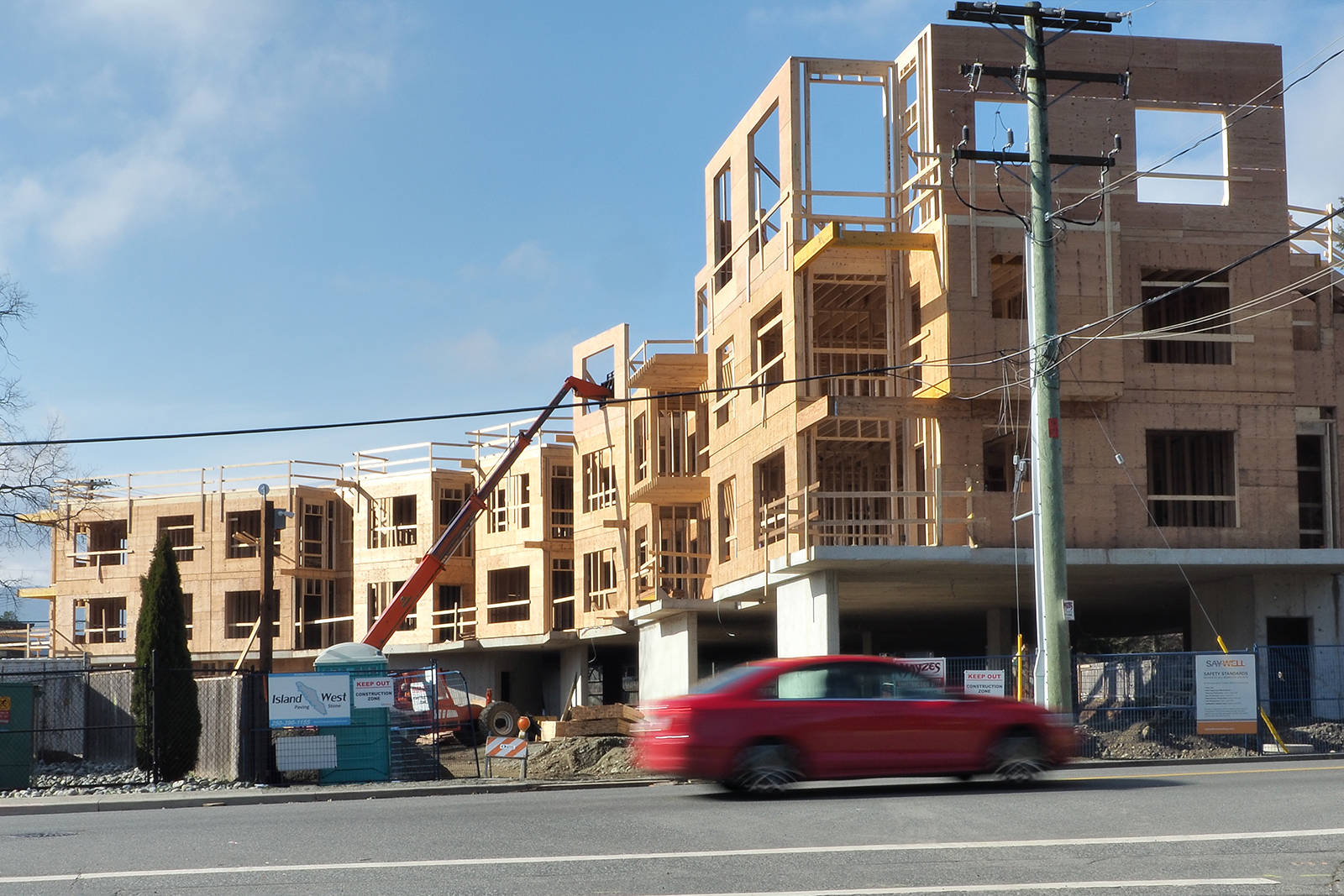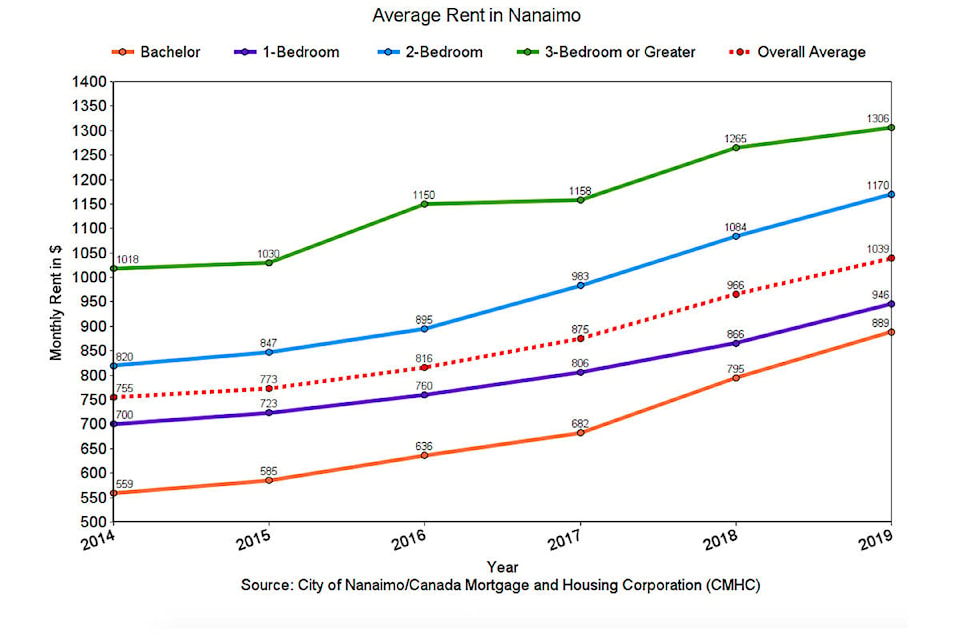The cost of renting an apartment in Nanaimo continues to climb despite more units becoming available, a new report outlining the city’s overall economic health shows.
According to the City of Nanaimo’s recently released 2020 State of the Nanaimo Economy report, the average private apartment rent in the city last year was $1,039 per month, an increase of eight per cent from the previous year.
The increase came even though the number of available rental units increased by 3.2 per cent, according to the report, which notes that more than 30 per cent of residents live in rental accommodations.
The average monthly rent of a bachelor suite in 2019 increased by 11 per cent to $889, the average one-bedroom apartment rent rose seven per cent to $946 per month, and the average two-bedroom rent was $1,170 in 2019, up eight per cent from 2018.
Nanaimo’s vacancy rate was two per cent in 2019, the report notes.
I created a chart to illustrate how much rental prices have increased in #Nanaimo since 2014.
The average rent for a one-bedroom apartment in 2014 was $700/month. By 2019 the average one-bedroom was $946/month, a 35% increase. pic.twitter.com/CbpfyiiFeY
— Nicholas M Pescod (@npescod) February 27, 2020
Amrit Manhas, the city’s economic development officer and author of the report, told the News Bulletin the reason for higher rents, even with the addition of more units, mostly comes down to supply and demand.
“Nanaimo’s high quality of life at a fraction of the cost of other cities is continuing to attract a lot of new residents to our area,” she said.
The City of Nanaimo’s population was 98,957 in 2019, an increase of about 1.4 per cent from the year before according to the 2020 economic report, which notes that the population is expected to increase to 106,254 by 2024.
“In the last census and since the last census our population has been growing at a much higher pace than British Columbia, the Regional District of Nanaimo, coastal Vancouver and even the Canadian average,” Manhas said. “We’re growing at a much higher pace than all of those geographies and I think that will continue to put pressure on the housing supply.”
Increasingly higher rent and rock-bottom vacancy rates have become the norm in Nanaimo over the last half-dozen years.
According to Canada Mortgage and Housing Corporation, the overall average monthly rent for a purpose-built apartment in Nanaimo increased by 39 per cent between 2014-2019, with the average rent for a one-bedroom increasing by 38 per cent and the average two-bedroom rent increasing by 44 per cent.
Data on the city’s website also shows that Nanaimo’s vacancy rate cratered from eight per cent in 2013 to just 1.6 per cent in 2017, before increasing slightly to 2.5 per cent in 2018. Additionally, 440 purpose-built rental apartment units have been built in the city since 2015, bringing the total number of units to 3,978.
Manhas said while Nanaimo’s vacancy dropped down to two per cent last year, it remains higher than the rates in Victoria and Vancouver. She said not all of the new rental units that have been built are online at the moment.
“Even though we have added more rental units into the market, they may not be available yet because it can take a little while for those units to actually hit the market,” she said.
Also included in the 2020 economic report was information regarding incomes and wages in Nanaimo. In 2019, nearly 19 per cent of households in Nanaimo reported an annual income between $20,000 and $39,999, while 32 per cent of households reported an annual income of $100,000 or higher in 2019, with 1.7 per cent of households reporting an income exceeding $299,999.
Manhas said the city is aware that even though incomes are increasing, there is an affordable rental issue and is working toward implementing its affordable housing strategy.
“We’re looking at a number of things in that strategy to address this issue,” she said. “Some of those include looking at short-term regulations, looking at density bonusing for developers in exchange for affordable housing, looking at a land acquisition strategy for affordable housing.”
READ ALSO: Nanaimo’s affordable housing strategy addresses struggles that renters face
Signy Madden, executive director with United Way Central and Northern Vancouver Island, said higher average rents are making it harder for those making less than $40,000 annually to build financial security and move upward financially.
“If you’re paying $1,100 a month for an apartment, that gives you almost no income left over to save or do anything and that is very clearly what is happening in the community right now,” she said.
Madden called Nanaimo’s geographic location, climate, and lower cost of living relative to other major urban centres a “blessing and a curse.”
“We’re getting a lot of younger people moving to this community because it is still more affordable than Victoria or Vancouver,” she said. “We’re seen as a desirable place to live and the affordability issues elsewhere in the province has pushed people to move to Nanaimo.”
That increase in newcomers to the city is fuelling the demand for housing, particularly rental housing, according to Madden.
“It’s a trickle-down effect…” she said. “Now, there is more pressure on the limited availability of affordable rent in the city because people are either being pushed out of larger markets or choosing a different lifestyle here.”
According to the 2020 economic report, the retail, food services and accommodation sector employed approximately 23 per cent of workers in the city last year. Madden said one concern she has is that many private-sector jobs, particularly those in the retail and food service sector, have lower wages which haven’t risen nearly as fast as the cost of rent.
“What we’re seeing on the ground is there are people working in restaurants, working in retail and their wages have not increased significantly over the last number of years,” she said. “You’re not necessarily getting a living wage working at Woodgrove.”
Madden said she’s pleased to see the city has created an affordable housing strategy and task force addressing homelessness because they will generate “longer-term” solutions. She said the solution to addressing the issue around higher rents is more complex than simply building larger and taller apartment buildings.
“As taxpayers and voters we need to support economic development initiatives and affordable housing strategies…” she said. “We also need a broader range of non-market housing, which is affordable rental housing and assisted homeownership. The market forces will drive market housing, but the government and taxpayers are going to have to drive the other types of emergency, supportive and non-market housing. That is something we have to get our head around.”
READ ALSO: Province partners on new affordable apartments in Harewood
READ ALSO: Affordable housing won’t happen on its own
Follow @npescod
nicholas.pescod@nanaimobulletin.com
Like us on Facebook and follow us on Twitter and Instagram

